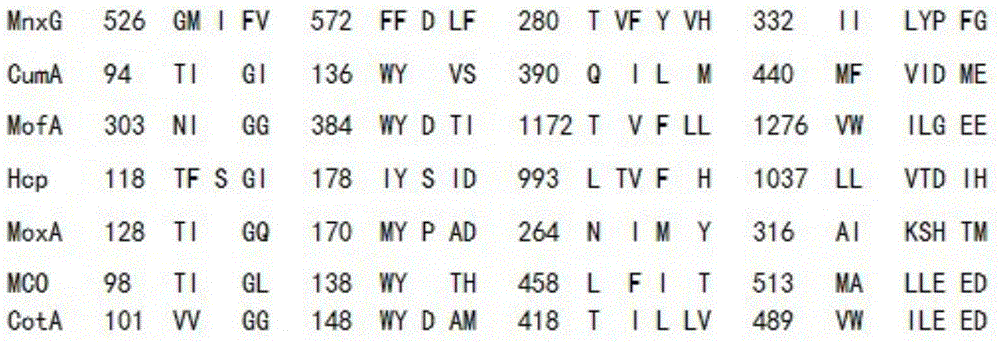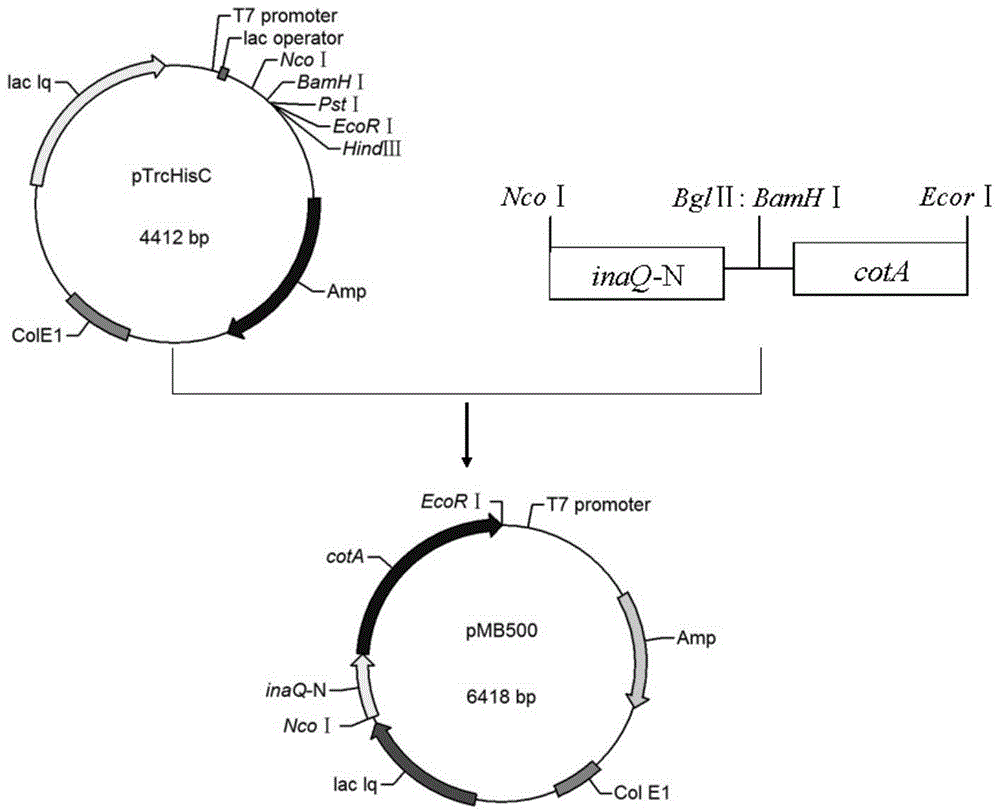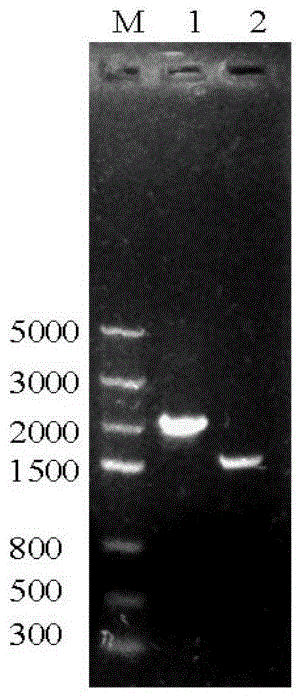Manganese oxidation engineering bacterium for Escherichia coli and application of manganese oxidation engineering bacterium to environmental hormone degradation
A technology of Escherichia coli and environmental hormones, applied in the field of environmental remediation, can solve problems such as the persistence of toxic residual degradation effects, and achieve the effects of wide degradable substrates, improved thermal stability, and high practical value
- Summary
- Abstract
- Description
- Claims
- Application Information
AI Technical Summary
Problems solved by technology
Method used
Image
Examples
Embodiment 1
[0071] The cotA gene of spore coat protein was amplified in A56 manganese oxidizing strain, and the function of CotA protein was analyzed.
[0072] The applicant has isolated Bacillus A56 with high manganese oxidation activity in the laboratory, from which the cotA gene is amplified. The gene of cotA in A56 has a total of 1530bp, and its sequence is shown in SEQ ID NO.1.
[0073] Using DNAMAN to analyze the CotA amino acid sequence of A56, CotA is composed of 509 amino acids, the protein molecular weight is 58.6kDa, and the isoelectric point is 6.12. The amino acid sequence was analyzed by NCBI for the conserved domain, and the results showed that CotA contains three conserved copper ion binding sites, which are similar to the subunit domain of cytochrome C oxidase, and are the same as a variety of multi-copper oxidases. source. CotA is thus a multi-copper oxidase. And it does not contain signal peptide sequence and transmembrane structural threshold.
[0074] Comparing th...
Embodiment 2
[0076] The construction of Escherichia coli manganese oxidizing engineering bacteria, the steps are as follows:
[0077] The cotA gene of the A56 bacterial strain was artificially synthesized, and the gene sequence was shown in SEQIDNO.1. The cotA fragment and the plasmid pMB102 (pTrcHisC-inaQN-gfp) (Improved phosphate biosorption by bacterial surface display of phosphate-bindingproteinutilizingicenucleationprotein.FEMSMicrobiolLett2009, 299, (1), 44-52) were restricted by Endonucleases BamHI and EcoRI were used to digest, and the required fragments were recovered, and enzyme-ligated under the action of T4 ligase to obtain recombinant plasmid pMB500, such as figure 2 , pMB500 was transformed into Escherichia coli DH5α, and the transformants were subjected to rapid detection and PCR amplification verification, PCR amplification of inaQ-N (inpN1, TGCCATGGATCTCGAVAAGGCGTTGGTGC; inpN2, TAAGATCTGGTCTGCAAATTCTGCGGCGTCG) and cotA gene (cotF2, 5'GCGTCG) respectively GGATCC ATGAACCTAG...
Embodiment 3
[0090] The preparation method of MB500 genetically engineered bacteria:
[0091] Use LB medium to subculture the recombinant bacteria (1LLB medium: 5 g of yeast extract, 10 g of tryptone, 10 g of sodium chloride, pH 7.0-7.2.). Pick a single colony and inoculate it into a 5ml PA bottle containing LB medium, and culture overnight at 37°C.
PUM
| Property | Measurement | Unit |
|---|---|---|
| Molecular weight | aaaaa | aaaaa |
Abstract
Description
Claims
Application Information
 Login to View More
Login to View More - R&D Engineer
- R&D Manager
- IP Professional
- Industry Leading Data Capabilities
- Powerful AI technology
- Patent DNA Extraction
Browse by: Latest US Patents, China's latest patents, Technical Efficacy Thesaurus, Application Domain, Technology Topic, Popular Technical Reports.
© 2024 PatSnap. All rights reserved.Legal|Privacy policy|Modern Slavery Act Transparency Statement|Sitemap|About US| Contact US: help@patsnap.com










